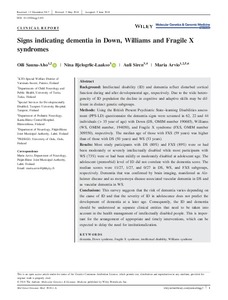Signs indicating dementia in Down, Williams and Fragile X syndromes
Maria Arvio; Nina Bjelogrlic‐Laakso; Auli Siren; Oili Sauna‐Aho
https://urn.fi/URN:NBN:fi-fe2021042719625
Tiivistelmä
Background: Intellectual disability (ID) and dementia reflect disturbed cortical function during and after developmental age, respectively. Due to the wide heterogeneity of ID population the decline in cognitive and adaptive skills may be different in distinct genetic subgroups.
Methods: Using the British Present Psychiatric State–learning Disabilities assessment (PPS‐LD) questionnaire the dementia signs were screened in 62, 22 and 44 individuals (> 35 year of age) with Down (DS, OMIM number 190685), Williams (WS, OMIM number, 194050), and Fragile X syndrome (FXS, OMIM number 309550), respectively. The median age of those with FXS (59 years) was higher than of those with DS (50 years) and WS (53 years).
Results: Most study participants with DS (80%) and FXS (89%) were or had been moderately or severely intellectually disabled while most participants with WS (73%) were or had been mildly or moderately disabled at adolescent age. The adolescent (premorbid) level of ID did not correlate with the dementia score. The median scores were 11/27, 1/27, and 0/27 in DS, WS, and FXS subgroups, respectively. Dementia that was confirmed by brain imaging, manifested as Alzheimer disease and as moya‐moya disease associated vascular dementia in DS and as vascular dementia in WS.
Conclusions: This survey suggests that the risk of dementia varies depending on the cause of ID and that the severity of ID in adolescence does not predict the development of dementia at a later age. Consequently, the ID and dementia should be understood as separate clinical entities that need to be taken into account in the health management of intellectually disabled people. This is important for the arrangement of appropriate and timely interventions, which can be expected to delay the need for institutionalization.
Kokoelmat
- Rinnakkaistallenteet [27094]
